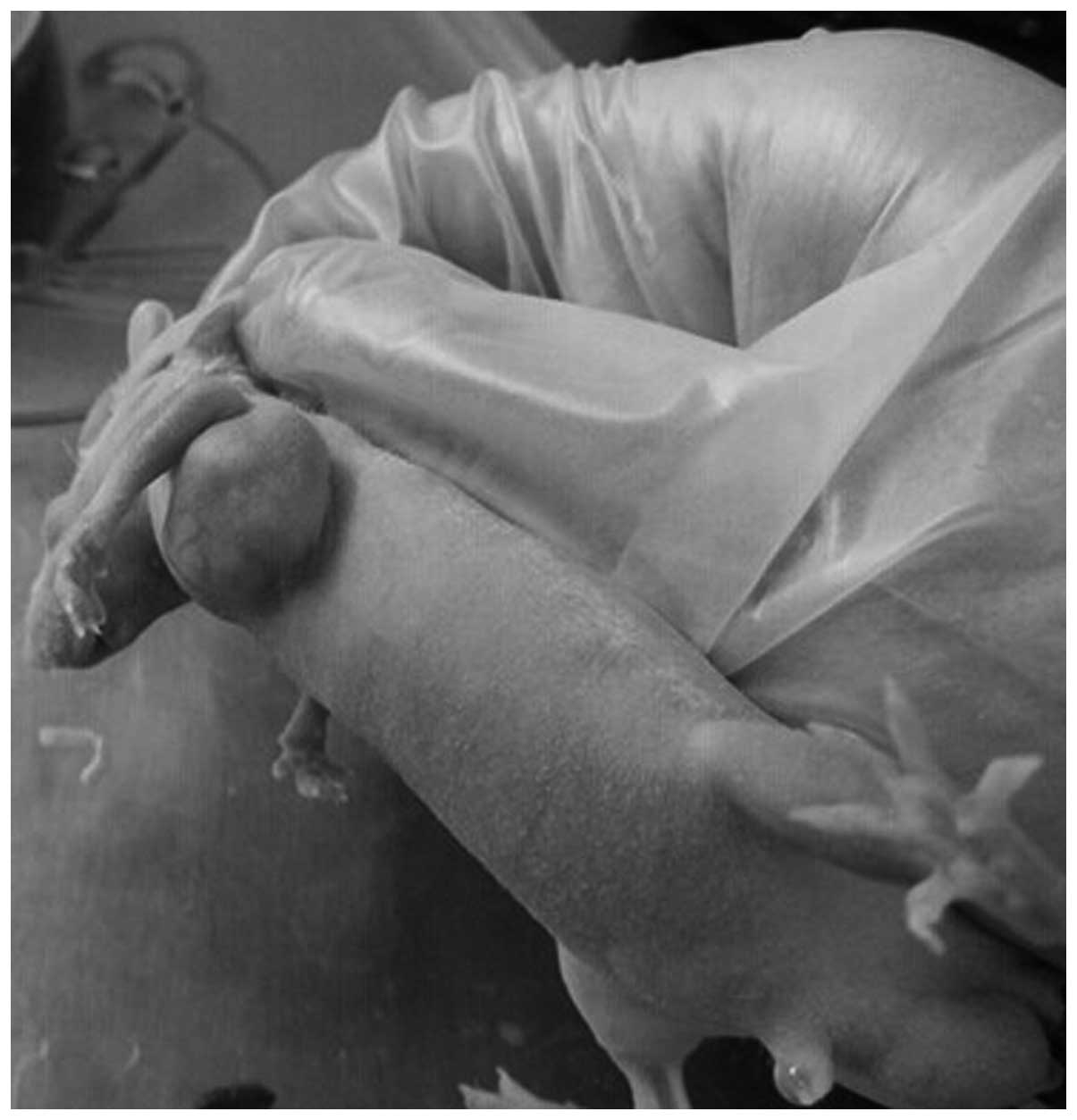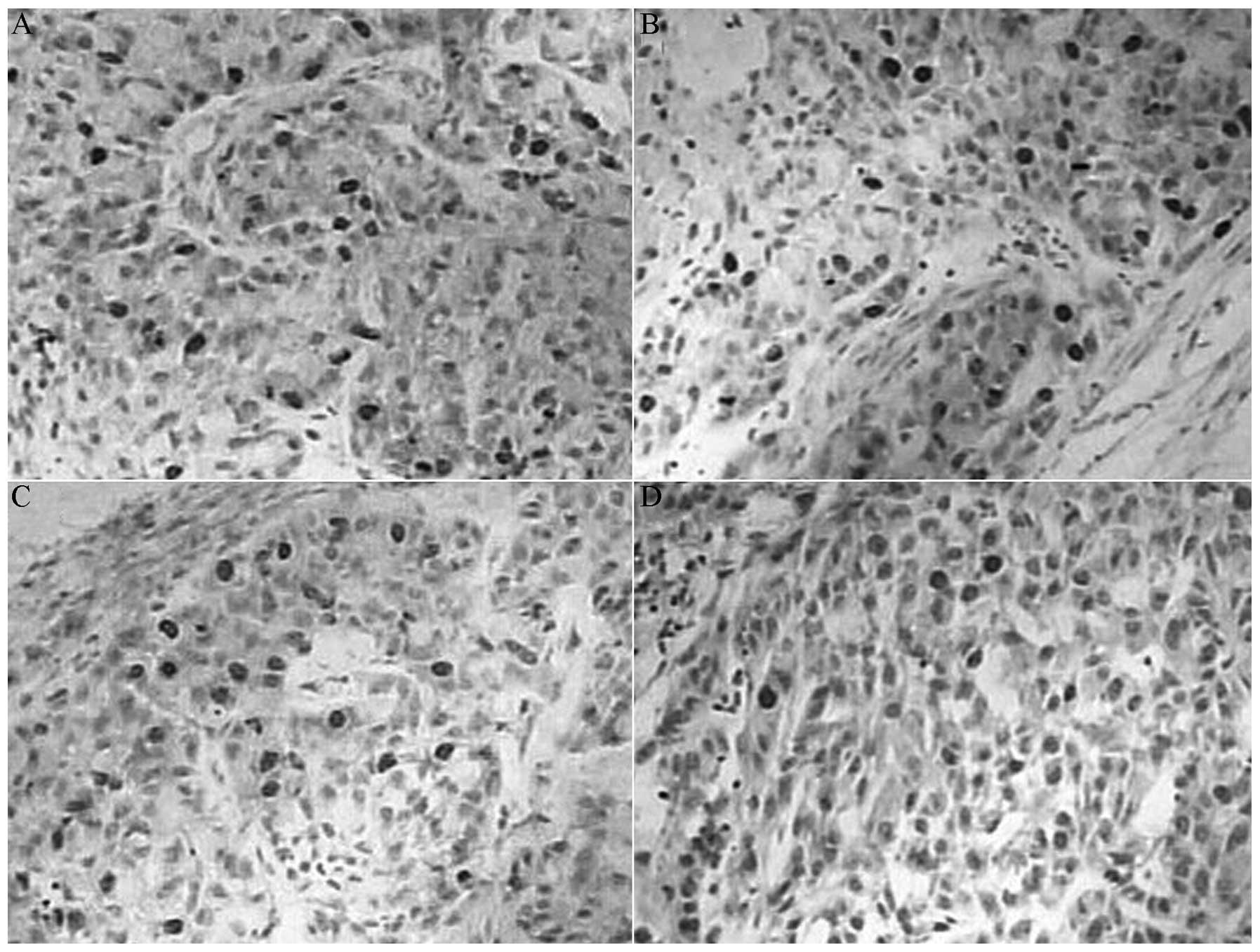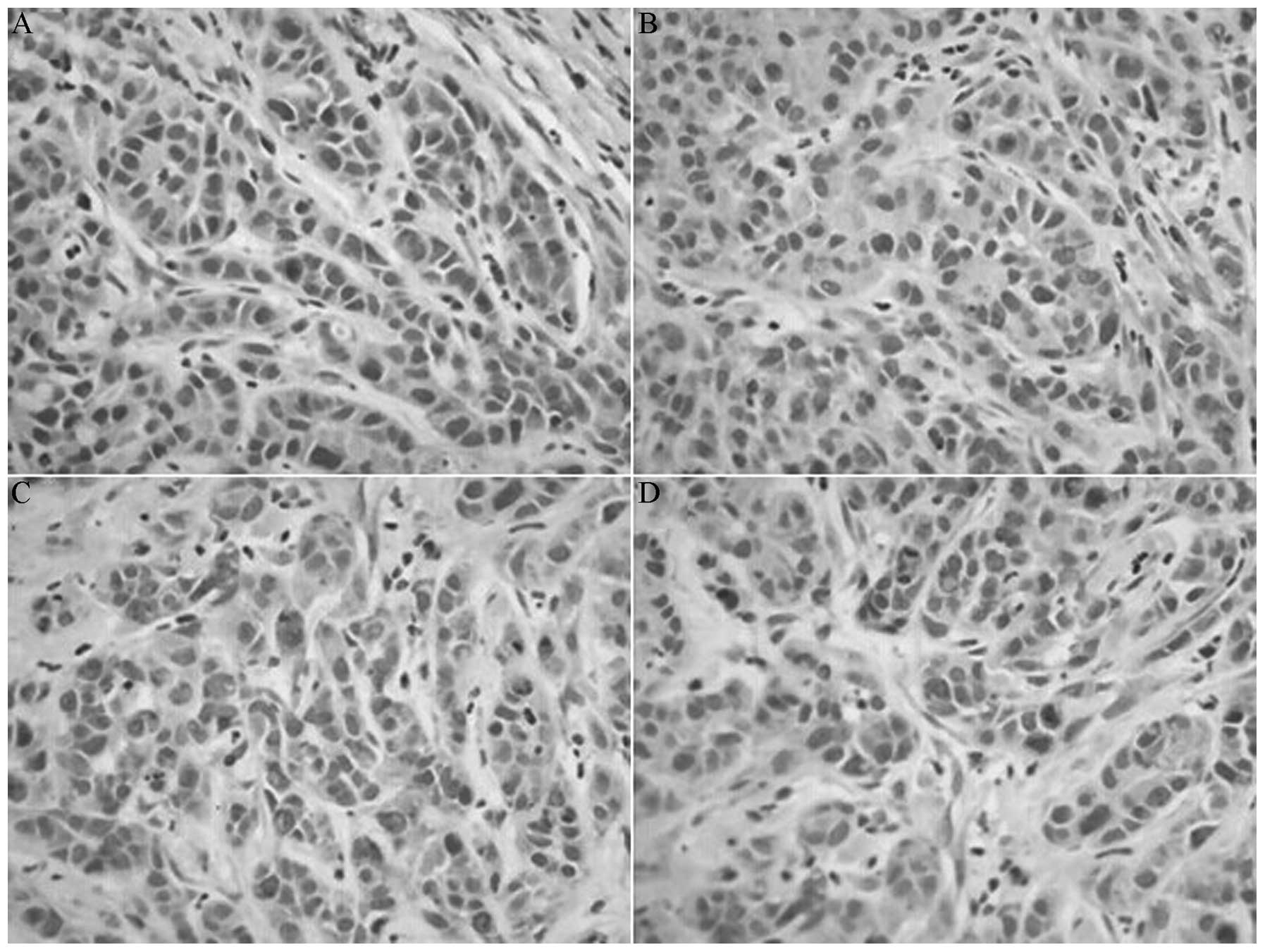|
1
|
Di Nicolantonio JJ, McCarty MF, Chatterjee
S, Lavie CJ and O'Keefe JH: A higher dietary ratio of long-chain
omega-3 to total omega-6 fatty acids for prevention of
COX-2-dependent adenocarcinomas. Nutr Cancer. 66:1279–1284. 2014.
View Article : Google Scholar : PubMed/NCBI
|
|
2
|
Han H, Yang S, Lin SG, Xu CS and Han ZH:
Effects and mechanism of downregulation of COX-2 expression by RNA
interference on proliferation and apoptosis of human breast cancer
MCF-7 cells. Mol Med Rep. 10:3092–3098. 2014.PubMed/NCBI
|
|
3
|
Li M, Tan SY and Wang XF: Paeonol exerts
an anticancer effect on human colorectal cancer cells through
inhibition of PGE2 synthesis and COX-2 expression. Oncol
Rep. 32:2845–2853. 2014.PubMed/NCBI
|
|
4
|
Harris RE, Casto BC and Harris ZM:
Cyclooxygenase-2 and the inflammogenesis of breast cancer. World J
Clin Oncol. 5:677–692. 2014. View Article : Google Scholar : PubMed/NCBI
|
|
5
|
Shao Y, Sun K, Xu W, Li XL, Shen H and Sun
WH: Helicobacter pylori infection, gastrin and
cyclooxygenase-2 in gastric carcinogenesis. World J Gastroenterol.
20:12860–12873. 2014. View Article : Google Scholar : PubMed/NCBI
|
|
6
|
Athanassiou-Papaefthymiou M, Shkeir O, Kim
D, et al: Evaluation of CD44 variant expression in oral, head and
neck squamous cell carcinomas using a triple approach and its
clinical significance. Int J Immunopathol Pharmacol. 27:337–349.
2014.PubMed/NCBI
|
|
7
|
Zhao S, He JL, Qiu ZX, Chen NY, Luo Z,
Chen BJ and Li WM: Prognostic value of CD44 variant exon 6
expression in non-small cell lung cancer: A meta-analysis. Asian
Pac J Cancer Prev. 15:6761–6766. 2014. View Article : Google Scholar : PubMed/NCBI
|
|
8
|
Hua D, Kong W, Zheng X, et al: Potent
tumor targeting drug release system comprising MMP-2 specific
peptide fragment with self-assembling characteristics. Drug Des
Devel Ther. 8:1839–1849. 2014.PubMed/NCBI
|
|
9
|
Kamyab-Hesari K, Mohtasham N, Aghazadeh N,
Biglarian M, Memar B and Kadeh H: The expression of MMP-2 and Ki-67
in head and neck melanoma, and their correlation with
clinic-pathologic indices. J Cancer Res Ther. 10:696–700.
2014.PubMed/NCBI
|
|
10
|
Budak M, Korpinar MA, Kalkan T and Tuncel
H: Mutation detection in the promoter region of survivin gene on
N-methyl-N-nitrosourea induced colon tumor model in experiment.
Bratisl Lek Listy. 115:554–556. 2014.PubMed/NCBI
|
|
11
|
Abd El-Hakim TF, El-Shafie MK, Abdou AG,
Azmy RM, El-Naidany SS and Badr El-Din MO: Value of urinary
survivin as a diagnostic marker in bladder cancer. Anal Quant
Cytopathol Histpathol. 36:121–127. 2014.PubMed/NCBI
|
|
12
|
Faibish D, Suzuki M and Bartlett JD:
Appropriate real-time PCR reference genes for fluoride treatment
studies performed in vitro or in vivo. Arch Oral Biol. 62:33–42.
2016. View Article : Google Scholar : PubMed/NCBI
|
|
13
|
Turk HM, Camci C, Sevinc A, Bukyukberber
S, Sari I and Adli M: Cyclooxygenase-2 expression is not a marker
of poor survival in lung cancer. Asian Pac J Cancer Prev.
13:315–318. 2012. View Article : Google Scholar : PubMed/NCBI
|
|
14
|
Ranger GS: Current concepts in colorectal
cancer prevention with cyclooxygenase inhibitors. Anticancer Res.
34:6277–6282. 2014.PubMed/NCBI
|
|
15
|
Quidville V, Segond N, Pidoux E, Cohen R,
Jullienne A and Lausson S: Tumor growth inhibition by indomethacin
in a mouse model of human medullary thyroid cancer: implication of
cyclooxygenases and 15-hydroxyprostaglandin dehydrogenase.
Endocrinology. 145:2561–2571. 2004. View Article : Google Scholar : PubMed/NCBI
|
|
16
|
Di Francesco AM, Ruggiero A and Riccardi
R: Cellular and molecular aspects of drugs of the future:
Oxaliplatin. Cell Mol Life Sci. 59:1914–1927. 2002. View Article : Google Scholar : PubMed/NCBI
|
|
17
|
Avoranta ST, Korkeila EA, Syrjänen KJ,
Pyrhönen SO and Sundström JT: Lack of CD44 variant 6 expression in
rectal cancer invasive front associates with early recurrence.
World J Gastroenterol. 18:4549–4556. 2012. View Article : Google Scholar : PubMed/NCBI
|
|
18
|
Dommann SN, Ziegler T, Dommann-Schener CC,
Meyer J, Panizzon R and Burg G: CD44v6 is a marker for systemic
spread in cutaneous T-cell lymphomas. A comparative study between
nodal and cutaneous lymphomas. J Cutan Pathol. 22:407–412. 1995.
View Article : Google Scholar : PubMed/NCBI
|
|
19
|
Liang YZ, Fang TY, Xu HG and Zhuo ZQ:
Expression of CD44v6 and Livin in gastric cancer tissue. Chin Med J
(Engl). 125:3161–3165. 2012.PubMed/NCBI
|
|
20
|
Protin U, Schweighoffer T, Jochum W and
Hilberg F: CD44-deficient mice develop normally with changes in
subpopulations and recirculation of lymphocyte subsets. J Immunol.
163:4917–4923. 1999.PubMed/NCBI
|
|
21
|
Matsumura Y and Tarin D: Significance of
CD44 gene products for cancer diagnosis and disease evaluation.
Lancet. 340:1053–1058. 1992. View Article : Google Scholar : PubMed/NCBI
|
|
22
|
Indinnimeo M, Cicchini C, Giarnieri E,
Stazi A, Mingazzini PL and Stipa V: Evaluation of CD44 variant 6
expression and clinicopathological factors in pulmonary metastases
from colon carcinoma. Oncol Rep. 10:1875–1877. 2003.PubMed/NCBI
|
|
23
|
Röcken M: Early tumor dissemination, but
late metastasis: Insights into tumor dormancy. J Clin Invest.
120:1800–1803. 2010. View
Article : Google Scholar : PubMed/NCBI
|
|
24
|
Maehara Y, Kabashima A, Koga T, Tokunaga
E, Takeuchi H, Kakeji Y and Sugimachi K: Vascular invasion and
potential for tumor angiogenesis and metastasis in gastric
carcinoma. Surgery. 128:408–416. 2000. View Article : Google Scholar : PubMed/NCBI
|
|
25
|
Ko YH, Won HS, Jeon EK, Hong SH, Roh SY,
Hong YS, Byun JH, Jung CK and Kang JH: Prognostic significance of
CD44s expression in resected non-small cell lung cancer. BMC
Cancer. 11:3402011. View Article : Google Scholar : PubMed/NCBI
|
|
26
|
Skubitz AP: Adhesion molecules. Cancer
Treat Res. 107:305–329. 2002.PubMed/NCBI
|
|
27
|
Cho HJ, Kim HR, Park YS, Kim YH, Kim DK
and Park SI: Prognostic value of survivin expression in stage III
non-small cell lung cancer patients treated with platinum-based
therapy. Surg Oncol. 24:329–334. 2015. View Article : Google Scholar : PubMed/NCBI
|
|
28
|
Tao YF, Lu J, Du XJ, Sun LC, Zhao X, Peng
L, Cao L, Xiao PF, Pang L, Wu D, et al: Survivin selective
inhibitor YM155 induce apoptosis in SK-NEP-1 Wilms tumor cells. BMC
Cancer. 12:6192012. View Article : Google Scholar : PubMed/NCBI
|
|
29
|
Andersson SE, Svensson MN, Erlandsson MC,
Dehlin M, Andersson KM and Bokarewa MI: Activation of Fms-like
tyrosine kinase 3 signaling enhances survivin expression in a mouse
model of rheumatoid arthritis. PLoS One. 7:e476682012. View Article : Google Scholar : PubMed/NCBI
|
|
30
|
Jarrin M, Mansergh FC, Boulton ME, Gunhaga
L and Wride MA: Survivin expression is associated with lens
epithelial cell proliferation and fiber cell differentiation. Mol
Vis. 18:2758–2769. 2012.PubMed/NCBI
|
|
31
|
Liu W, Zhu F, Jiang Y, Sun D, Yang B and
Yan H: siRNA targeting survivin inhibits the growth and enhances
the chemosensitivity of hepatocellular carcinoma cells. Oncol Rep.
29:1183–1188. 2013.PubMed/NCBI
|
|
32
|
MacDonald BT, Tamai K and He X:
Wnt/beta-catenin signaling: Components, mechanisms, and diseases.
Dev Cell. 17:9–26. 2009. View Article : Google Scholar : PubMed/NCBI
|
|
33
|
Bongiovanni L, D'Andrea A, Porcellato I,
Ciccarelli A, Malatesta D, Romanucci M, Della Salda L, Mechelli L
and Brachelente C: Canine cutaneous melanocytic tumours:
significance of β-catenin and survivin immunohistochemical
expression. Vet Dermatol. 26:270–e59. 2015. View Article : Google Scholar : PubMed/NCBI
|
|
34
|
Katsube K, Sakamoto K, Tamamura Y and
Yamaguchi A: Role of CCN, a vertebrate specific gene family, in
development. Dev Growth Differ. 51:55–67. 2009. View Article : Google Scholar : PubMed/NCBI
|
|
35
|
Hou CH, Chiang YC, Fong YC and Tang CH:
WISP-1 increases MMP-2 expression and cell motility in human
chondrosarcoma cells. Biochem Pharmacol. 81:1286–1295. 2011.
View Article : Google Scholar : PubMed/NCBI
|
|
36
|
Jiang L, Luo RY, Yang J and Cheng YX:
Knockdown of survivin contributes to antitumor activity in
cisplatin-resistant ovarian cancer cells. Mol Med Rep. 7:425–430.
2013.PubMed/NCBI
|
|
37
|
Mao Y, Chen H, Lin Y, Xu X, Hu Z, Zhu Y,
Wu J, Xu X, Zheng X and Xie L: microRNA-330 inhibits cell motility
by downregulating Sp1 in prostate cancer cells. Oncol Rep.
30:327–333. 2013.PubMed/NCBI
|

















